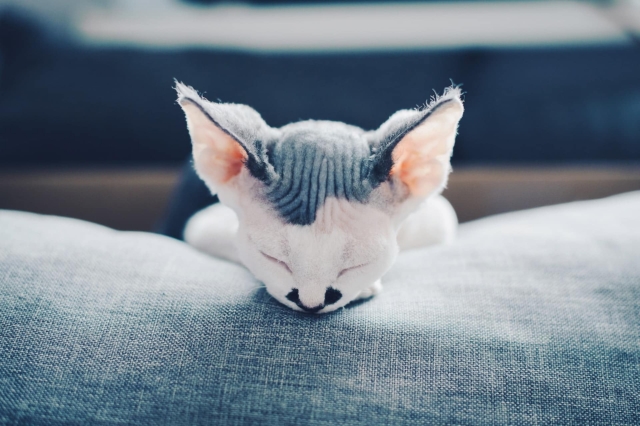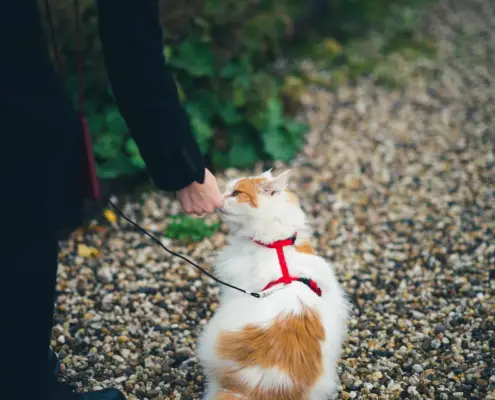
Cats have long been admired for their mysterious and captivating gaze. Their eyes seem to hold an otherworldly depth, as if they can see beyond the ordinary. But have you ever wondered just how far cats can see? In this article, we will delve into the fascinating world of cats’ visual perception, exploring their near and far vision, the role of their peripheral vision, and the factors that affect their visual experience.
Anatomy of a cat’s eye
To understand cats’ visual perception, we must first examine the unique anatomy of their eyes. Cats have large, round pupils that can dilate to a remarkable extent, allowing for enhanced light intake in low-light conditions. This adaptation gives them a distinct advantage when hunting during twilight or in the dark.
Additionally, cats possess a reflective layer behind their retinas called the tapetum lucidum. This layer acts like a mirror, bouncing light back through the retina and increasing the sensitivity of their vision. It is responsible for the mesmerizing glow you may have noticed when a cat’s eyes catch the light.
Understanding cats’ near vision
While cats are known for their exceptional night vision, their near vision is not as sharp as that of humans. They have a more limited ability to focus on objects up close, which is why you may see them appear slightly cross-eyed when inspecting something nearby. This is due to the structure of their eyes, which have a higher concentration of rod cells for low-light vision and fewer cone cells for sharp focus.
However, this doesn’t mean that cats are unable to see objects up close. They can still discern details, but their visual acuity is better suited for distant objects. It is their extraordinary far vision that truly sets them apart.
How far can cats see?
Cats have an impressive ability to see far into the distance. While humans have a visual acuity of approximately 20/20, cats can see with a visual acuity of about 20/100. This means that what a human with normal vision can see clearly at 100 feet, a cat can see with the same clarity from 20 feet away.
Their heightened far vision is attributed to the structure of their eyes and the presence of a higher concentration of rod cells. This allows them to detect subtle movements from a distance and spot potential prey or dangers. It’s no wonder cats have been successful hunters throughout history.
The role of peripheral vision in cats
In addition to their exceptional far vision, cats also possess an impressive peripheral vision. While humans have a field of view of approximately 180 degrees, cats have a field of view of nearly 200 degrees. This wide peripheral vision allows them to detect movement and objects in their surroundings without having to turn their heads, making them incredibly alert and responsive to their environment.
The combination of their far vision and expansive peripheral vision gives cats a comprehensive visual perception that surpasses our own. They have a heightened awareness of their surroundings, making them skilled predators and agile climbers.
Factors that affect a cat’s visual perception
Several factors can influence a cat’s visual perception. One significant factor is age. Just like humans, cats’ vision can deteriorate with age, and they may develop conditions such as cataracts or glaucoma. Regular veterinary check-ups are essential to monitor and address any potential vision issues.
Another factor is breed. Some cat breeds, such as the Siamese or the Persian, may have different visual capabilities due to variations in their eye structure. It is important to consider these differences when understanding a cat’s visual perception.
Comparing cats’ vision to humans
While cats’ visual abilities are impressive, they are not superior to humans in every aspect. Humans have better color vision, thanks to the presence of three types of cone cells that allow us to see a broad spectrum of colors. Cats, on the other hand, have fewer cone cells and are believed to see the world in shades of blue and gray.
Additionally, cats have a lower visual acuity for near vision compared to humans. We have the advantage of being able to focus on objects up close with greater precision. However, when it comes to far vision and peripheral vision, cats undoubtedly outshine us.
Common misconceptions about cats’ vision
There are several misconceptions about cats’ vision that have persisted throughout the years. One common myth is that cats are completely colorblind. While it is true that they do not see colors the same way humans do, they can still perceive certain colors, albeit in a more limited range.
Another misconception is that cats can see in total darkness. While they do have superior night vision, they still require at least some ambient light to see clearly. Their ability to see in low-light conditions is exceptional, but not absolute darkness.
Enhancing cats’ visual experience
Now that we have a deeper understanding of cats’ visual perception, it’s important to consider ways in which we can enhance their visual experience. Providing a stimulating environment with various textures, heights, and objects can enrich their visual stimulation. Incorporating toys that mimic prey movements can also engage their natural hunting instincts and keep them mentally and visually stimulated.
Regular playtime and exercise are crucial for maintaining a cat’s overall well-being, including their visual health. Engaging in interactive play sessions not only strengthens the bond between cats and their owners but also provides valuable mental and visual stimulation.
Conclusion
Cats possess a remarkable visual perception that allows them to see far into the distance and detect subtle movements with their peripheral vision. Their unique eye structure and adaptations make them skilled hunters and agile climbers. While their near vision may be slightly inferior to ours, their far vision and wide field of view more than compensate for it.
Understanding cats’ visual perception is not only fascinating but also essential for providing them with an environment that caters to their natural instincts. By enhancing their visual experience through play, stimulation, and regular veterinary care, we can ensure that our feline companions enjoy a world of limitless visual possibilities.
If you enjoyed my article, I would appreciate you sharing it with your network.

Sima Ndlebe
Sima writes for CatBuzz. He is interested in Cats, Health and Fitness, and Entrepreneurship.
Published: 30 October 2023




